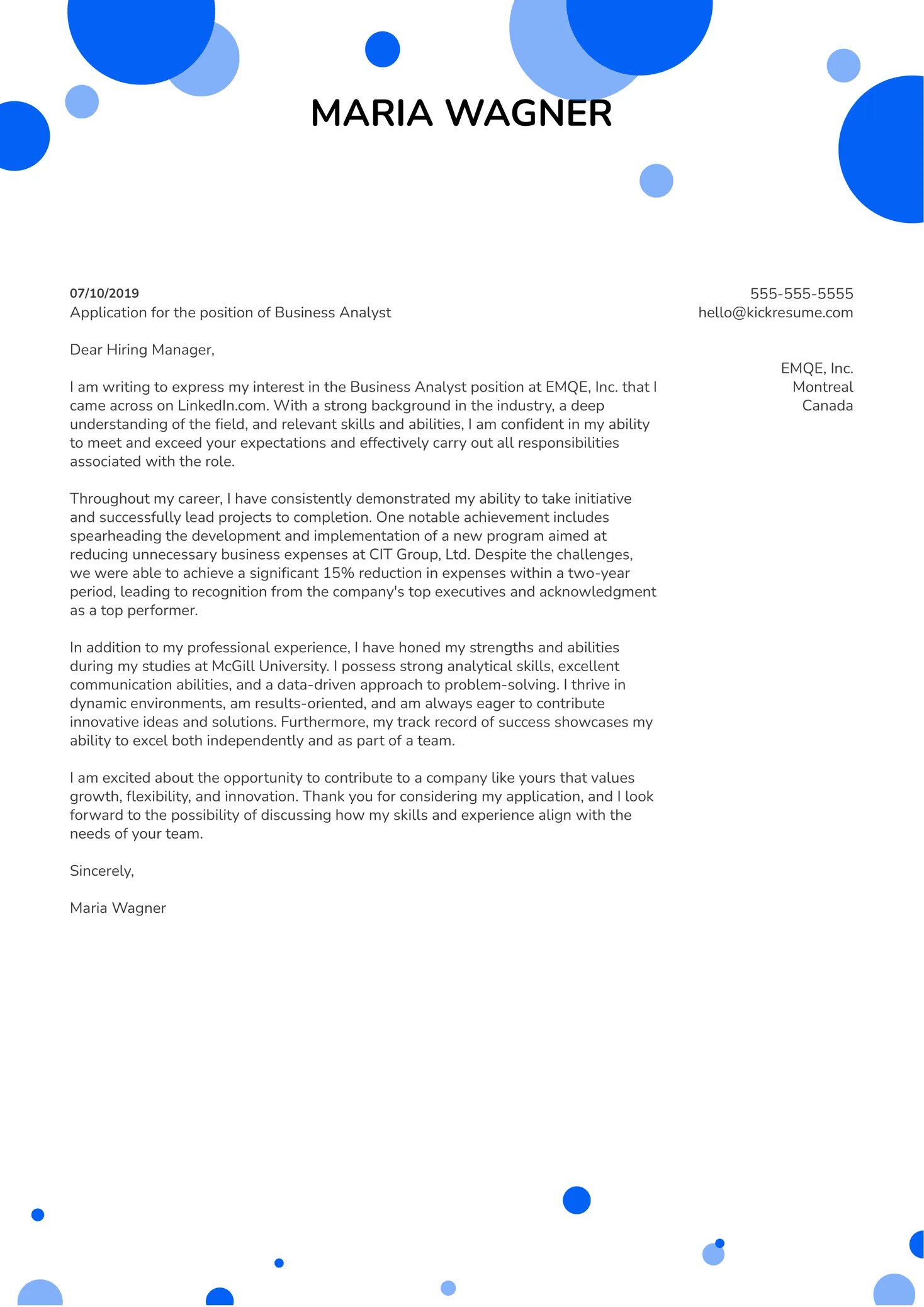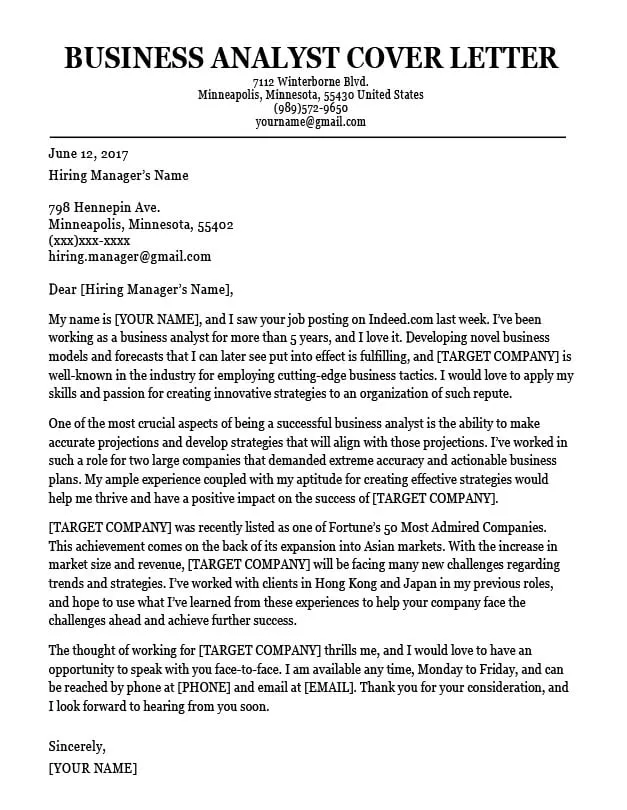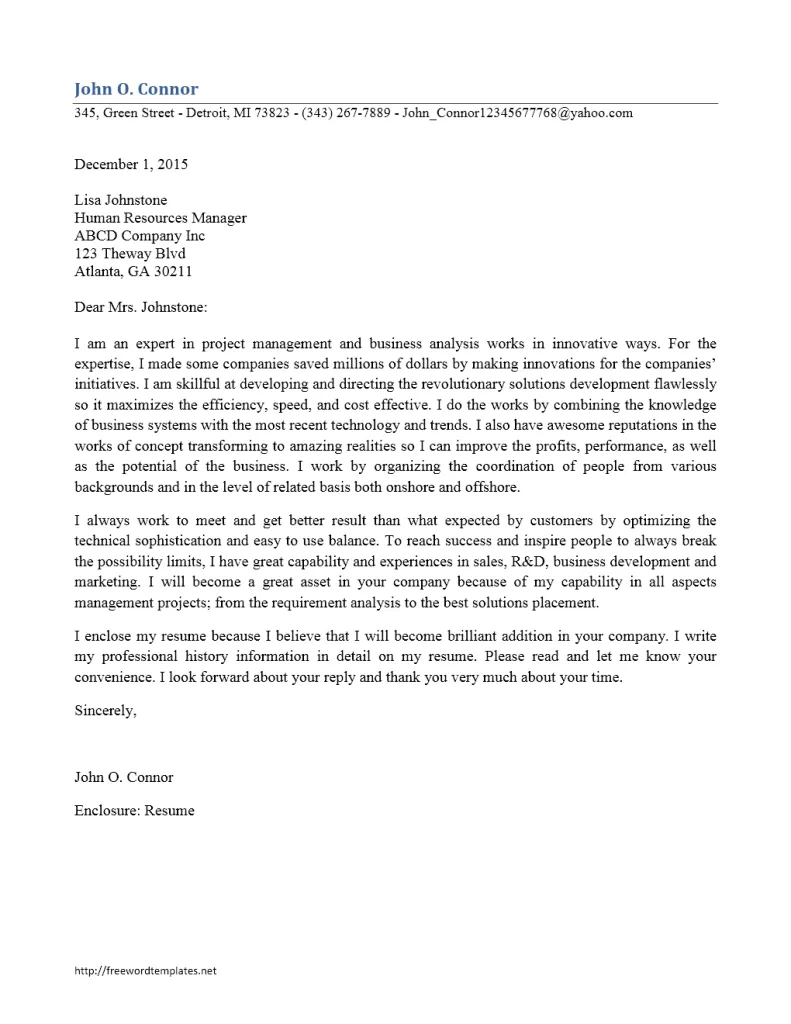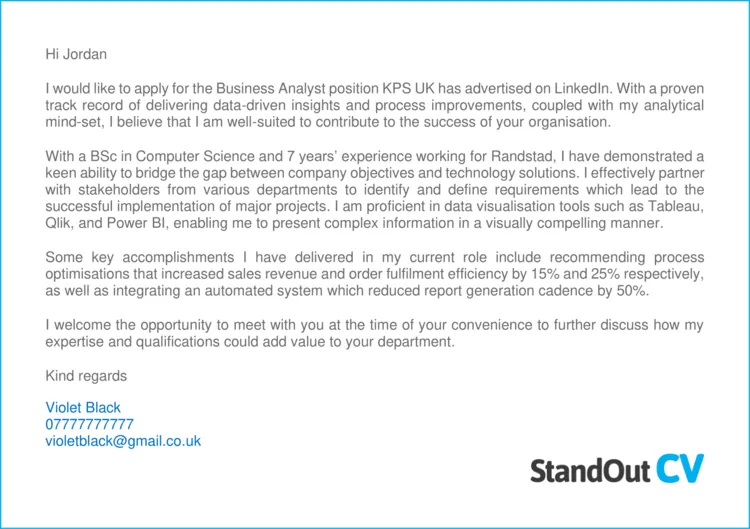What is a Business Analyst Cover Letter
A business analyst cover letter is a crucial document that accompanies your resume when applying for a business analyst position. It serves as your first direct communication with a potential employer, providing an opportunity to introduce yourself, highlight your key skills and experience, and express your interest in the specific role and company. A well-crafted cover letter can significantly increase your chances of securing an interview by making a strong first impression and showcasing your suitability for the position. It’s an opportunity to go beyond the bullet points of your resume and demonstrate your personality, writing skills, and genuine enthusiasm for the business analyst field. By tailoring your cover letter to each specific job application, you can effectively communicate why you are the ideal candidate and what value you bring to the organization.
Key Components of a Business Analyst Cover Letter
A compelling business analyst cover letter consists of several key components that, when combined, create a persuasive and professional document. These components include clear and concise contact information, both for you and the hiring manager (if available), a personalized greeting, an engaging opening paragraph, a section highlighting your relevant skills and experience, quantifiable achievements, a demonstration of your knowledge of the role and the company, and a strong closing statement. Each element plays a vital role in effectively communicating your qualifications and enthusiasm. By carefully structuring and crafting each part, you can create a cover letter that captures the hiring manager’s attention and encourages them to delve deeper into your qualifications.
Your Contact Information

At the top of your cover letter, clearly state your contact information. This typically includes your full name, phone number, email address, and optionally, your LinkedIn profile URL. This ensures that the hiring manager can easily reach you to schedule an interview or request further information. Make sure the information is accurate and up-to-date. Using a professional-sounding email address is crucial. This part of your cover letter is not just about providing details; it is about making it easy for the employer to connect with you. A clean and well-presented contact section reflects your attention to detail, a crucial quality for a business analyst.
The Hiring Manager’s Contact Information
If you know the hiring manager’s name, address your cover letter to them directly. This shows that you have taken the time to research the company and the role, demonstrating your genuine interest. Include the hiring manager’s name, title, and the company’s address. If you are unable to find the hiring manager’s name, you can use a general salutation, such as “Dear Hiring Manager.” Addressing the letter to a specific person personalizes your application and makes it more likely to resonate with the reader. Researching this information shows initiative and attention to detail, traits highly valued in a business analyst.
Greeting the Hiring Manager
Begin your cover letter with a professional greeting. If you know the hiring manager’s name, use “Dear Mr./Ms./Mx. [Last Name].” If the name is unavailable, use a general greeting like “Dear Hiring Manager.” Avoid generic greetings like “To Whom It May Concern.” Personalizing your greeting immediately engages the reader and sets a positive tone. It indicates you have taken the initiative to identify the key decision-maker, showcasing your attention to detail and your enthusiasm for the role. This simple act can significantly impact the overall impression you make.
Opening Paragraph Grabbing Attention

The opening paragraph is your opportunity to capture the hiring manager’s attention. Start with a concise and compelling statement that immediately highlights your interest in the position and the company. Mention where you found the job posting and express your enthusiasm for the opportunity. Briefly introduce yourself and your primary skills and experience. Avoid generic introductions. Instead, use a hook that showcases your understanding of the company’s needs or your passion for the business analyst field. This initial paragraph should entice the reader to continue reading, demonstrating that you are a strong candidate and that you have something valuable to offer.
Highlighting Your Skills and Experience
In the main body of your cover letter, focus on your relevant skills and experience, tailoring them to the specific requirements outlined in the job description. Provide specific examples of how you have used your skills to achieve success in previous roles. Mention key skills, such as requirements gathering, data analysis, process improvement, and stakeholder management. Use action verbs to describe your accomplishments, and avoid simply listing your responsibilities. Explain how your skills align with the company’s needs and demonstrate your ability to contribute to their goals. This section allows you to present a compelling narrative of your capabilities.
Quantifying Your Achievements
Whenever possible, quantify your achievements using numbers and data to demonstrate the impact of your work. Instead of saying, “Improved business processes,” state “Improved business processes, resulting in a 15% reduction in operational costs.” Quantifying your achievements adds credibility to your claims and provides concrete evidence of your abilities. This approach showcases your analytical skills and your results-oriented mindset, essential qualities for a business analyst. Quantifiable accomplishments make your cover letter more persuasive and memorable.
Demonstrating Your Knowledge of the Role

Show that you understand the role of a business analyst and the company’s specific needs. Research the company’s mission, values, and recent projects. Mention any relevant industry experience or knowledge you possess. Explain how your skills and experience align with the company’s goals and how you can contribute to their success. This demonstrates your genuine interest and shows that you are not just applying for any job but are specifically interested in this opportunity. This tailored approach makes your cover letter stand out and shows that you’ve done your homework.
Addressing the Company’s Needs
In your cover letter, clearly address the company’s needs as outlined in the job description. Identify the key challenges or projects the company is focused on and explain how your skills and experience can help them achieve their goals. Showcase your understanding of the business analyst role and how you can contribute to solving their problems. This demonstrates that you have carefully considered the role and are confident in your ability to add value to the organization. Tailor your response to each specific job application to maximize your chances of success. This shows a proactive approach and shows you are aligned with their objectives.
Closing the Cover Letter
Conclude your cover letter with a strong closing paragraph summarizing your interest in the position and reiterating your key qualifications. Express your enthusiasm for the opportunity and reiterate your desire to contribute to the company’s success. Keep your closing concise and professional, and make sure to thank the hiring manager for their time and consideration. Avoid clichés and instead, express your genuine interest and confidence in your ability to perform the role. Your closing is an opportunity to leave a lasting positive impression.
Expressing Gratitude and Next Steps

In your closing, express your gratitude for the hiring manager’s time and consideration. State your availability for an interview and indicate how you can be contacted. Reiterate your enthusiasm for the opportunity and your confidence in your ability to make a significant contribution. You can also mention that you look forward to hearing from them soon. A clear and professional closing statement leaves a positive final impression and encourages the hiring manager to move forward in the hiring process.
Cover Letter Formatting and Style
Ensure your cover letter is well-formatted, easy to read, and free of errors. Use a professional font, such as Times New Roman or Arial, and maintain consistent formatting throughout the document. Keep the letter concise, typically no more than one page. Use clear and concise language, avoiding jargon or overly complex sentences. Ensure your cover letter is well-structured and easy to navigate. Proper formatting and style demonstrate your attention to detail and professionalism. A well-formatted cover letter is visually appealing and creates a positive impression.
Proofreading and Editing Your Cover Letter
Before submitting your cover letter, carefully proofread and edit it for any grammatical errors, typos, or inconsistencies. Use spell-check and grammar-check tools, but also read the document carefully yourself. Ask a friend or colleague to review your cover letter for clarity and accuracy. A polished and error-free cover letter demonstrates professionalism and attention to detail. Proofreading ensures that your cover letter accurately reflects your skills and experience and leaves a positive impression on the hiring manager.
